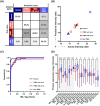Extracellular Vesicle Proteome Analysis Improves Diagnosis of Recurrence in Triple-Negative Breast Cancer
- PMID: 40545963
- PMCID: PMC12183389
- DOI: 10.1002/jev2.70089
Extracellular Vesicle Proteome Analysis Improves Diagnosis of Recurrence in Triple-Negative Breast Cancer
Abstract
We explored the diagnostic utility of tumor-derived extracellular vesicles (tdEVs) in breast cancer (BC) by performing comprehensive proteomic profiling on plasma samples from 130 BC patients and 40 healthy controls (HC). Leveraging a microfluidic chip-based isolation technique optimized for low plasma volume and effective contaminant depletion, we achieved efficient enrichment of tdEVs. Proteomic analysis identified 26 candidate biomarkers differentially expressed between BC patients and HCs. To enhance biomarker selection robustness, we implemented a hybrid machine learning framework integrating LsBoost, convolutional neural networks, and support vector machines. Among the identified candidates, four EV proteins. ECM1, MBL2, BTD, and RAB5C. not only exhibited strong discriminatory performance, particularly for triple-negative breast cancer (TNBC), but also demonstrated potential relevance to disease recurrence, providing prognostic insights beyond initial diagnosis. Receiver operating characteristic (ROC) curve analysis demonstrated high diagnostic accuracy with an area under the curve (AUC) of 0.924 for BC and 0.973 for TNBC, as determined by mass spectrometry. These findings were further substantiated by immuno assay validation, which yielded an AUC of 0.986 for TNBC. Collectively, our results highlight the potential of EV proteomics as a minimally invasive, blood-based platform for both accurate detection and recurrence risk stratification in breast cancer and its aggressive subtypes, offering promising implications for future clinical applications.
Keywords: diagnosis; machine learning; microfluidics; proteomic analysis; triple‐negative breast cancer; tumour derived extracellular vesicles.
© 2025 The Author(s). Journal of Extracellular Vesicles published by Wiley Periodicals LLC on behalf of International Society for Extracellular Vesicles.
Conflict of interest statement
The authors declare no conflicts of interest.
Figures







Similar articles
-
Machine Learning-Based Prognostic Gene Signature for Early Triple-Negative Breast Cancer.Cancer Res Treat. 2025 Jul;57(3):731-740. doi: 10.4143/crt.2024.937. Epub 2024 Nov 19. Cancer Res Treat. 2025. PMID: 39563200 Free PMC article.
-
Cost-effectiveness of using prognostic information to select women with breast cancer for adjuvant systemic therapy.Health Technol Assess. 2006 Sep;10(34):iii-iv, ix-xi, 1-204. doi: 10.3310/hta10340. Health Technol Assess. 2006. PMID: 16959170
-
Signs and symptoms to determine if a patient presenting in primary care or hospital outpatient settings has COVID-19.Cochrane Database Syst Rev. 2022 May 20;5(5):CD013665. doi: 10.1002/14651858.CD013665.pub3. Cochrane Database Syst Rev. 2022. PMID: 35593186 Free PMC article.
-
Magnetic resonance perfusion for differentiating low-grade from high-grade gliomas at first presentation.Cochrane Database Syst Rev. 2018 Jan 22;1(1):CD011551. doi: 10.1002/14651858.CD011551.pub2. Cochrane Database Syst Rev. 2018. PMID: 29357120 Free PMC article.
-
Three-dimensional saline infusion sonography compared to two-dimensional saline infusion sonography for the diagnosis of focal intracavitary lesions.Cochrane Database Syst Rev. 2017 May 5;5(5):CD011126. doi: 10.1002/14651858.CD011126.pub2. Cochrane Database Syst Rev. 2017. PMID: 28472862 Free PMC article.
References
-
- Bandu, R. , Oh J. W., and Kim K. P.. 2024. “Extracellular Vesicle Proteins as Breast Cancer Biomarkers: Mass Spectrometry‐based Analysis.” Proteomics 24: 2300062. - PubMed
-
- Baptistella, A. R. , Landemberger M. C., Dias M. V., et al. 2019. “Rab5C Enhances Resistance to Ionizing Radiation in Rectal Cancer.” Journal of Molecular Medicine (Berlin) 97: 855–869. - PubMed
MeSH terms
Substances
Grants and funding
- C-2023-0006/Severance Hospital Research Fund for Clinical Excellence grant
- 2020003030007/Korea Environmental Industry and Technology Institute
- 1485019157/Korea Environmental Industry and Technology Institute
- 2014R1A6A9064166/National Research Foundation of Korea
- 2021R1A2C3011254/National Research Foundation of Korea
LinkOut - more resources
Full Text Sources
Miscellaneous

